|
|||||||||
|
ARTICLESThe Lei Family BuildersWhile a sense of anonymity, and indeed of conformity, seems to loom over the imperial structures of the Manchu-Qing dynasty in Beijing and surrounds, as well as over the buildings that survived from the Ming era, there is one family that left its mark on the built heritage of late-dynastic China. The Lei family, originally from Jiangxi province, provided design and architectural talent to the Qing court for some two hundred years, from the mid Kangxi reign (1662-1722) up until the Republic of China (1912). According to the family genealogy, the first Lei family builder was Lei Fada. Although the family had moved to Jiangning (present-day Nanjing) and worked on palace construction during the Ming, it was not until 1683 that Lei Fada and his relatives relocated to Beijing. The work of the Lei family spans some seven generations, and it includes many of the post-Ming buildings within the Forbidden City, the pavilions at the Sea Palaces (Zhongnanhai and Beihai), the Garden of Perfect Brightness (or what were then called the 'Five Gardens', see Editorial), the rebuilt Summer Palace (Yihe Yuan), the Qing tombs and many other key structures. The Lei were also crucially involved with the reworking of the building codes that delineated the kind and style of structures created for the Qing nobility, in particular the princely mansions or wangfu. Some claim that their designs even covered the imperial roadways, dams and many items in everyday use by the court and nobility. Outside Beijing and the imperial properties around the city, they designed on imperial order many of the extensive structures at the Imperial Mountain Villa at Chengde, the detached palace (xinggong) on the West Lake in Hangzhou at Gushan (now Zhongshan Park), as well as buildings in the early Qing capital Shengjing (present day Shenyang) and elements of the tombs outside that city. 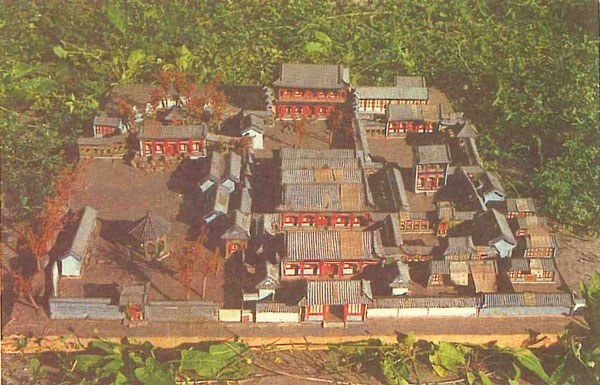 Fig. 1 A model (tangyang) of the Fuchun Tang complex made by the Lei family builders during the Tongzhi-era restoration of the Yuanming Yuan. Fuchun Tang (also known as Yongchun Tang) was located in the Qichun Yuan gardens in the south-east corner of the larger garden complex. Built in the reign of Qianlong's son, Yuyan (Jiaqing reign, 1796-1820), it was used by Jiaqing as his living quarters and, during his successor's reign, it became the palace of the Empress Dowager. During the short-lived rebuilding of the Tongzhi reign in 1873, it was mooted that the repaired Fuchun Tang could serve the Empress Dowager Cixi's garden residence. Although the buildings were never restored, Cixi, who had lived at Yuanming Yuan during the Xianfeng reign (eventually giving birth to Xianfeng's son, Zaichun, later the Tongzhi emperor), did visit it a number of times. The buildings were destroyed during the 1900 Boxer Rebellion, and the modern Chinese-style buildings now provide administrative space for the Yuanming Yuan Management Office and a series of up-market villas (the 'Wanchun Yuan Villas' mentioned in the Editorial). Source: Liu Yang, Xiride xiagong: Yuanming Yuan, Beijing: Xueyuan Chubanshe, 2005, pp.157-158.
Fig. 1 A model (tangyang) of the Fuchun Tang complex made by the Lei family builders during the Tongzhi-era restoration of the Yuanming Yuan. Fuchun Tang (also known as Yongchun Tang) was located in the Qichun Yuan gardens in the south-east corner of the larger garden complex. Built in the reign of Qianlong's son, Yuyan (Jiaqing reign, 1796-1820), it was used by Jiaqing as his living quarters and, during his successor's reign, it became the palace of the Empress Dowager. During the short-lived rebuilding of the Tongzhi reign in 1873, it was mooted that the repaired Fuchun Tang could serve the Empress Dowager Cixi's garden residence. Although the buildings were never restored, Cixi, who had lived at Yuanming Yuan during the Xianfeng reign (eventually giving birth to Xianfeng's son, Zaichun, later the Tongzhi emperor), did visit it a number of times. The buildings were destroyed during the 1900 Boxer Rebellion, and the modern Chinese-style buildings now provide administrative space for the Yuanming Yuan Management Office and a series of up-market villas (the 'Wanchun Yuan Villas' mentioned in the Editorial). Source: Liu Yang, Xiride xiagong: Yuanming Yuan, Beijing: Xueyuan Chubanshe, 2005, pp.157-158.
At the Garden of Perfect Brightness, the large exhibition hall at the Western Palaces, in the area designated since the 1990s as a site for patriotic education (aiguozhuyi jiaoyu jidi), has models of many of the main buildings, pavilions and scenes (jing) of the gardens. While these are of contemporary manufacture, they are close copies of the models (tangyang) made by the Lei for the consideration of the Tongzhi emperor and the empresses Ci'an and Cixi when restoration work on the gardens was undertaken in the 1870s. Such to-scale models would be presented, along with detailed floor plans, for consideration and approval by the throne. The models provide a view on the inner workings of court planning, design and architecture. For the delectation of the refined eye, however, Qianlong commissioned an album of 'Forty Views of Yuanming Yuan', delicate paintings on silk that accompanied his own poems. 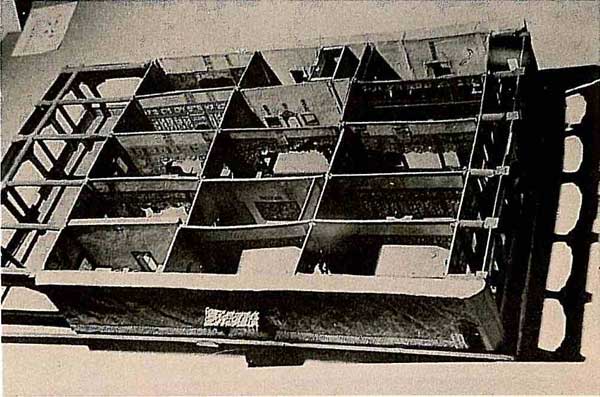 Fig. 2 A tangyang or model of the main hall of an imperial residence at Tiandi yijia chun in the Wanchun Yuan garden of Yuanming Yuan dating from the abortive Tongzhi-era reconstruction. Source: Huang Taopeng and Huang Zhongjuan, eds, Yuanming Yuan: Zhongguo lishishangde yidai mingyuan, Hong Kong: Sanlian Shudian Xianggang Fendian, 1985, p.130. Meanwhile, the Jesuit designers of the Western Pavilions created a set of engravings of the buildings and fountains of their design, the plates for which are now housed in La Bibliothèque nationale de France. Models of these Western Palaces are on display in vitrines dotting the area outside the main exhibition hall in the Western Pavilions ruins precinct. After the devastation of 1860, and in light of the demands of the foreign powers that they be allowed permanent diplomatic representation in the imperial capital, Prince Gong (Yixin, 1833-1898), the brother of the Xianfeng emperor (Yizhu, 1831-1861) who had been charged with dealing with the invaders, suggested (daresay with a sense of bitter irony) that perhaps the diplomats could be housed in the largely unscathed Western Pavilions. 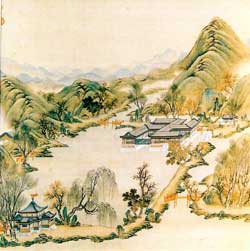 Fig. 3 A Qianlong-era painting of 'Wanfang Anhe' (Peace in All Directions) on silk. Source: Yuanming Yuan sishijing tuyong, Beijing: Yuanming Yuan, 1991.  Fig. 4 A model of Yongzheng's studio, 'Wanfang Anhe' (Peace in All Directions) made by the Lei family builders during the Tong-era restoration of the Yuanming Yuan. Source: Liu Yang, Xiride xiagong: Yuanming Yuan, p.39.
Fig. 4 A model of Yongzheng's studio, 'Wanfang Anhe' (Peace in All Directions) made by the Lei family builders during the Tong-era restoration of the Yuanming Yuan. Source: Liu Yang, Xiride xiagong: Yuanming Yuan, p.39.
Thus, despite the depredations of 1860, a Yuanming Yuan in miniature has existed in the models and the elaborate architectural drawings created by the Lei family. Indeed, it is these models that have allowed for the reconstructed displays of the garden (one of which is housed in a purpose built structure near the Lion Forest—Shizilin—southeast of the Western Pavilions) and that have inspired the numerous imitations found at theme parks and in gardens throughout China. They have also provided the scale and detail for the vision of digital designers who have been building virtual elements of the Garden of Perfect Brightness since the mid 1990s. Lei Tingchang (1845-1906) was the seventh generation of Lei builder-architects who served the imperial family. He worked on the restoration of the Garden of Perfect Brightness, overseeing the models made for the short-lived project, and then the reconstruction of the Qingyi Yuan, the rebuilt garden palace known in its restored form as Yihe Yuan (the Summer Palace in English). He also oversaw the expansion of the Sea Palaces favoured by the Empress Dowager and now the seat of both state and party power in China. While it is widely thought that Lei Tingchang was the last member of the Lei clan to serve the court, there is evidence that his descendants continued working on Chongling, the imperial tomb of the Guangxu emperor which was not completed until the early years of the Republic. Research would indicate that it was only in the late Xianfeng reign (1851-1861), around the time of the destruction of the Garden of Perfect Brightness, that the Lei—in particular Lei Jingxiu, the fifth generation of Lei builders—undertook a concerted effort to collect their designs in a systematic fashion. The plans were stored in a main 'planning office' (yangfang) located in the northeast corner of the Yuanming Yuan. Although it survived the razing of 1860, the Lei moved the archive out of the all but abandoned garden for safekeeping, and this was the beginning of the story of its transmission and dispersal. 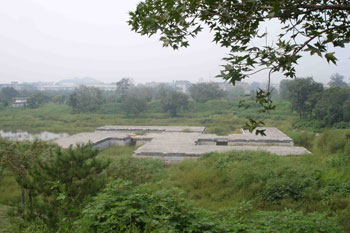 Fig. 5 The recently excavated and restored studio 'Wanfang Anhe', summer 2005. Photo: GRB.
Fig. 5 The recently excavated and restored studio 'Wanfang Anhe', summer 2005. Photo: GRB.
It is said that Lei Xianrui, one of Lei Tingchang's sons, sold most of the Lei archive (said to have been transported in ten cartloads) to the National Beiping Library in 1930. Other family members sold off the remaining materials to various institutions in the ensuing years. The Society for Research in Chinese Architecture (Yingzao xueshe) of the 1930s, especially Zhu Qiqian who wrote a study of the Lei clan (Yangshi Lei kao) began the work to preserve and conduct research into the heritage of this clan of imperial builders. There is now a major state project devoted to bringing order and access to the 'Lei Archives' (Yangshi Lei tudang), reportedly consisting of over 20,000 items, with some 12,000 of these in the collection of the National Library of China. 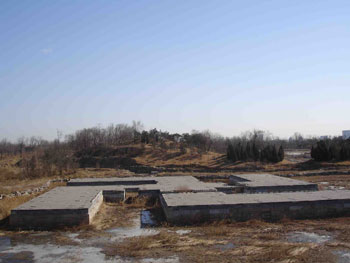 Fig. 6 The recently excavated and restored studio 'Wanfang Anhe', winter 2006. Photo: GRB.
Fig. 6 The recently excavated and restored studio 'Wanfang Anhe', winter 2006. Photo: GRB.
Since 1979, the Architecture Department of Tianjin University has been working on aspects of the Lei Archives, and in recent years much of the material in the National Library has been electronically catalogued and scanned. The scholars at Tianjin University were aided in 2000 by a project on the Lei Archive and, in 2002, state funding was allocated for the eventual publication of the material. An exhibition of some of the the Lei Archives housed in various collections, Chinese and international, was held at the National Library of China in August 2004, and there was talk of applying for UN Cultural Heritage status for the material in 2005. Efforts are also reportedly underway in Tianjin to create a Lei family museum in which plans and models will be exhibited. Displays of some of the original models have previously been mounted in Shenwumen, the northern entrance to the Forbidden City. If the plan to reconstruct the Garden of Perfect Brightness which have been debated with increasing fervor since the 1980s, ever proceed, be it on the original site, or in some new locale, the Lei family archive will play a vital role in the project. [GRB] |